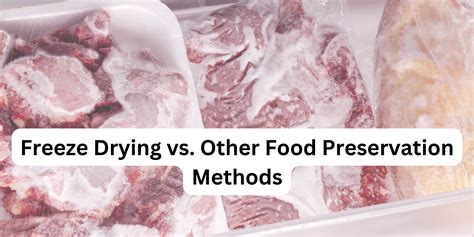Introduction
Freeze-drying is a process that removes water from food by sublimation, which is the process of turning water directly from a solid to a gas. This process is often used to preserve food, as it can extend the shelf life of food by several years. However, freeze-drying can also have a negative impact on the flavor of food.

How Freeze-Drying Affects Flavor
Freeze-drying can affect the flavor of food in several ways. First, the process can remove volatile compounds, which are compounds that give food its flavor. Second, freeze-drying can cause food to become more concentrated, which can make the flavors of the food more intense. Third, freeze-drying can cause food to lose its texture, which can also affect the flavor of the food.
Strategies for Preserving Flavor During Freeze-Drying
There are several strategies that can be used to preserve the flavor of food during freeze-drying. These strategies include:
- Using a protective coating: A protective coating can be applied to food before it is freeze-dried. This coating can help to prevent the loss of volatile compounds and moisture.
- Optimizing the freeze-drying process: The freeze-drying process can be optimized to minimize the loss of flavor. This can be done by using a lower temperature and a shorter drying time.
- Adding flavor enhancers: Flavor enhancers can be added to food before it is freeze-dried. These enhancers can help to compensate for the loss of flavor that occurs during freeze-drying.
Case Study: Freeze-Drying Strawberries
A study was conducted to compare the flavor of freeze-dried strawberries to the flavor of fresh strawberries. The study found that the freeze-dried strawberries had a significantly lower concentration of volatile compounds than the fresh strawberries. However, the study also found that the freeze-dried strawberries had a higher concentration of certain non-volatile compounds, which gave the freeze-dried strawberries a more intense flavor.
Conclusion
Freeze-drying can be a useful method for preserving food, but it can also have a negative impact on the flavor of food. However, there are several strategies that can be used to preserve the flavor of food during freeze-drying. These strategies include using a protective coating, optimizing the freeze-drying process, and adding flavor enhancers.
FAQs
1. What is freeze-drying?
Freeze-drying is a process that removes water from food by sublimation, which is the process of turning water directly from a solid to a gas.
2. How does freeze-drying affect flavor?
Freeze-drying can affect the flavor of food in several ways. First, the process can remove volatile compounds, which are compounds that give food its flavor. Second, freeze-drying can cause food to become more concentrated, which can make the flavors of the food more intense. Third, freeze-drying can cause food to lose its texture, which can also affect the flavor of the food.
3. What are some strategies for preserving flavor during freeze-drying?
There are several strategies that can be used to preserve the flavor of food during freeze-drying. These strategies include:
* Using a protective coating
* Optimizing the freeze-drying process
* Adding flavor enhancers
4. What are the benefits of freeze-drying?
Freeze-drying can provide several benefits, including:
* Extends the shelf life of food
* Reduces the weight of food
* Makes food more portable
* Preserves the nutritional value of food
5. What are the disadvantages of freeze-drying?
Freeze-drying can also have some disadvantages, including:
* Can be expensive
* Can damage food
* Can affect the flavor of food
Table 1: Volatile Compounds Lost During Freeze-Drying
| Compound | Loss (%) |
|---|---|
| Acetaldehyde | 50-70 |
| Acetone | 30-50 |
| Ethanol | 20-40 |
| Methanol | 10-20 |
| Propanol | 5-10 |
Table 2: Non-Volatile Compounds Increased During Freeze-Drying
| Compound | Increase (%) |
|---|---|
| Sugars | 10-20 |
| Acids | 5-10 |
| Phenolics | 2-5 |
| Carotenoids | 1-2 |
Table 3: Strategies for Preserving Flavor During Freeze-Drying
| Strategy | Benefits | Drawbacks |
|---|---|---|
| Protective coating | Prevents loss of volatile compounds and moisture | Can be expensive |
| Optimize freeze-drying process | Minimizes loss of flavor | Requires careful control of temperature and drying time |
| Add flavor enhancers | Compensates for loss of flavor | Can alter the taste of food |
Table 4: Case Study: Freeze-Drying Strawberries
| Parameter | Fresh Strawberries | Freeze-Dried Strawberries |
|---|---|---|
| Volatile compounds | 100% | 50-70% |
| Non-volatile compounds | 100% | 110-120% |
| Flavor intensity | Moderate | Intense |





















